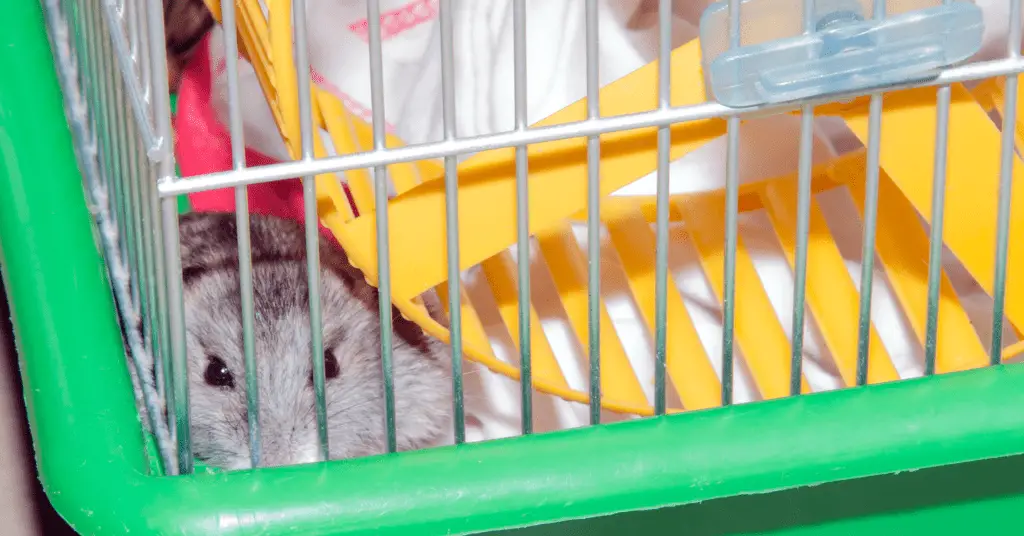Housing a mouse might seem pretty simple, right? Just buy a little cage, add some food and water, put in a few toys and you’re good to go. But then your mouse escapes. And it’s not just once. It happens again…and again. So what’s going on?
Do pet mice escape? Yes! But there are things you can do to help prevent it and to catch them when they do.

Mice are escape artists
Mice are amazing escape artists. They can squeeze through the smallest of spaces and are really good at finding their way out of cages. If there’s even the slightest chance they can get out, they will.
The main reason mice escape is because they’re bored. A mouse needs to have plenty of things to do in its cage to stay happy and healthy.
But even that isn’t enough, Because the other main reason mice escape is because they can! They’re just naturally curious creatures and love to explore.
Give them a small opening and they’ll be gone faster than you can count his whiskers.
That’s why it’s important to buy a cage specifically designed for small rodents like mice.
Because…

Prevention is easier than catching
Catching a mouse on the loose is not easy. They’re small, they’re fast and they know their way around your home better than you do.
The best way to deal with an escaped mouse is to prevent it from happening in the first place.
Here are some tips:
- Make sure the cage is escape-proof. This means getting a cage with small bars and cross bars. Mice can get threw as little as 1/4 inch gaps.
- Bars shouldn’t be made of anything that can be chewed threw
- Cage doors should latch, preferably at the top. Avoid magnetic doors. Check the cage regularly for any signs of chewing or damage.
- Avoid any cages that have large gaps between bars or no vertical or horizontal spacers preventing bending upwards outwards in which a mouse could squeeze threw.
- Always have a close cage, avoid ones with open tops.

What not to do
Don’t put your mouse in a completely enclosed space like a glass aquarium or fishbowl or Rubbermaid container.
Mice need fresh air and will suffocate in a closed space. Ammonia and other gasses can also build up and make your mouse sick.
Don’t use hot glue, super glue, or any other type of glue to secure the cage. Your mouse will chew right threw it.
If you find that your mouse has escaped, don’t panic. It’s important to stay calm so you can think clearly and take action quickly
Don’t put your mouse in a cage with bars that are too far apart. The gaps should be no larger than 1/4 inch.
If you find yourself with an escaped mouse, don’t panic! These little guys are fast and good at hiding. But there are some things you can do to try and catch them.

Catching a pet mouse that has escaped its enclosure
Even with all the precautions in the world, your mouse might still escape. If you find yourself with an escaped mouse, don’t panic!
These little guys are fast and good at hiding. But there are some things you can do to try and catch them.
The best way to catch an escaped pet mouse isn’t to hunt it down (unless you’ve trained it to come when called). First, Place some food and water somewhere in the house, in an open space where possible as close to the escaped mouse as you think it might be.
Mice are attracted to food, so this will hopefully lure him out of hiding. It will also keep him alive and hopefully well while we work on getting him back!
Another way to try and catch your mouse is to set up a live trap. You can buy these at most pet stores or online. You can also build one yourself.
Place the trap in an area where you’ve seen your mouse or where you think it might be.
A live catch bucket trap is a type of trap used to catch animals alive. It’s spectacular at what it does and is perfect to catch an escaped mouse without hurting him.
The trap consists of a bucket with a trap door on the top. Since you don’t want to hurt your pet mouse, add a cushion or blanket at the bottom of the bucket to break his fall.
The animal steps on the trap door, which springs open and drops the animal into the bucket.
Building a live catch bucket trap is relatively simple and can be done with a few basic tools. In addition, live catch traps are considered more humane than lethal traps, as they do not hurt or kill the animal.

What to do if you can’t catch it
If you still can’t seem to catch your mouse, It’s time to bring out stronger bait.
You can try using peanut butter, cheese, or even bacon. The stronger the smell, the better.
Place the bait in the live trap and check it every few hours.
Once you’ve finally caught your pet mouse, It’s time to put him back in his cage.
Make sure to do a thorough inspection of the cage to find out how he got out in the first place.
Fix any holes or gaps and make sure the cage is escape-proof before putting your mouse back in.
If even after all that you still can’t find your mouse – It might be time to face the fact that he’s gone for good.
While it’s unlikely, your mouse could have made his way outside and be long gone by now.
The best thing you can do at this point is to search your house thoroughly and set up food and water stations in the hopes that he’ll come back on his own.
It’s not uncommon for people to have found lost pets months after they’ve escaped captivity.
You should also alert your neighbors just in case they happen to see him in their gardens or on their property, You never know.
While it’s unlikely, There’s always a chance you’ll find your pet mouse safe and sound.


